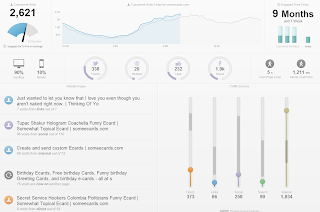As I
noted previously, with Webtrends Streams you can "see" things you haven't been able to see before. The fantastic challenge for us as we were starting to put it together was, now how do we show it? How do you provide a new lens into this new type of data? We had put together an incredibly powerful API, but that API data isn't really made for traditional data visualizations as the data is much more "alive". It is constantly moving, and flows as your visitors, and your customers, and your mobile app users interact with your sites and apps.

Let me take a step back, and explain a little more about the data. Webtrends Streams is an enriched stream of event-level data. It's not traditional pre-aggregated data that you find in real-time solutions. You subscribe to a stream of data, filtered and segmented to only see the data you're interested in, and as each event occurs, it's delivered to you. If you want to see more technical details, to the right is a small snippet of an event (in this case, a visitor arriving on a web page) that I just captured to show what I mean. Note that this is a very small snippet of all of the data that comes back. Every possible element that is collected, plus the additional enrichment we're adding in, can be consumed by you through subscribing to streams that are of interest to you.
Our first look at the data was even more rough than what you see above. It was our "bare bones" UI, and it was developer friendly, but didn't make much sense beyond the engineering floor at Webtrends. We started to think about how we could present it that might make sense to us, and came up with a few interesting views of the data, but realized that we needed to open it up to a wider team of creative folks. So we did what any respectful development team would do - and we brought in a bunch of food, and being in the great northwest, there might have been some beer there as well, and had one of our best Developer Day events ever.
The results from that day inspired us. We realized that these visualizations gave us the lens we were looking for to "show" Streams. You can see a couple of examples in
this video we created (no need to watch me...just skip to 16 seconds in and 40 seconds in). And the good news is that all of the visualizations were all built in html, css and javascript, so the development time is quick, and deployment is easy. There are so many powerful javascript libraries now for animating data (see the absolutely amazing work from
Mike Bostock at the NYTimes, and others working on
d3 as examples), that there's no excuse for building static reports anymore. Your data is alive. Your visualizations should reflect that.
At this point we knew we were on to something big. Not only was the data extremely compelling, but now we had a way to show it. A new way to express as-it-happens data. Instead of just explaining to customers that they can use the data to understand what's going on right now, we could show them. Are you launching a new site, or app, or campaign? Wouldn't it make sense to:
- Be able to validate that everything is setup as expected prior to launch, and troubleshoot any last minute measurement issues
- "See" each visitor as they are arriving, knowing how they got there, and what looks to be of interest
- Immediately validate whether your ad and search spend is working
- Note if your visitors are experiencing any errors, or trouble converting as expected, and fix those issues - while those same visitors are still on the site
These new visualizations gave us visibility into all of this level of understanding - and more. And the visualizations immediately resonated with our early adopter Streams customers. So much so that they asked for more, and started building out their own as well. Tell me, how awesome would it be to collaborate with your customers to create previously unheard of visualizations, and help them show off their data inside their company? Our customers are already doing this with us. And their work is truly inspiring.
Although we set out to provide Streams as a new API, we pivoted quickly and instead have created some fantastic visualizations to accompany the rich API data. Rather than show a bunch of screenshots of those visualizations (which do not do them justice at all), I'm going to create some videos to show it off. Look for those soon, and feel free to drop me a line (elbpdx @ gmail) if you'd like to chat more about all of this cool work.





